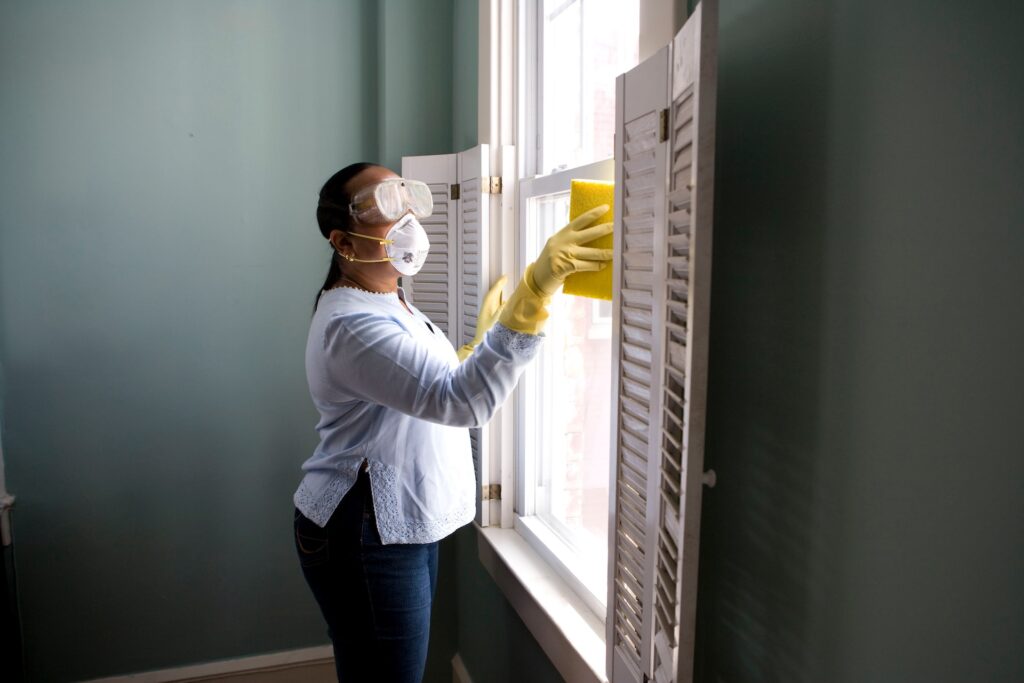Sandstone pavers add a touch of natural beauty to any outdoor area with their earthy colors and unique patterns. But like all outdoor materials, they need a bit of care to keep them looking great.
Since sandstone has a porous nature, it can soak up liquids that might leave stains or even damage the stones over time. That’s why it’s important to clean and maintain them the right way.
Whether you’re getting rid of everyday surface dirt or tackling tougher stains, you’ll learn how to clean sandstone pavers and keep them in top shape with our tips.
Key Takeaways
- Sweep sandstone regularly and use gentle cleaners that are safe for natural stone; don’t use harsh chemicals that can harm the surface.
- To remove stains, start with a bit of dish soap and careful scrubbing, then move to stone-specific cleaners if needed.
- Protect your sandstone by applying a sealer to keep away stains and wear; you’ll need to put on a new layer every few years.
- Pay attention to special situations like moss or bad weather, and act quickly to prevent permanent stains or damage.
- Professional sandstone cleaners have the right tools and knowledge to deep clean and protect sandstone pavers, saving you time and ensuring they look good for years.
Understanding Sandstone Pavers
Sandstone is a sedimentary rock composed of compacted sand and varies in color due to different mineral contents. It’s important to note that sandstone is porous, meaning it can absorb water and other substances, leading to potential staining or damage over time.
Now, why does this matter? Knowing what your pavers are made of helps you choose the right cleaning products and procedures. Some substances, like vinegar, can etch or stain the surface. Similarly, harsh scrubbing can cause scratches.
Steps to Take When Your Sandstone Pavers Become Dirty

Dust, algae, vegetation debris, and general foot traffic can all mar the surface of your pavers. As these pavers are porous, they can easily absorb stains, compromising their natural beauty.
So, how should you go about cleaning and maintaining your sandstone pavers to preserve their natural beauty and prolong their lifespan? Here are the simple steps:
Regular Cleaning
- Sweep your pavers regularly to remove any dirt and debris.
- Use a mild, neutral pH soap and water for a deeper clean.
Stain Removal
- For stubborn stains, use a non-acidic stone cleaner.
- Rinse thoroughly to avoid leaving residue behind.
Sealing
- Apply a quality sealant to protect your pavers from weathering and stains.
- Reapply the sealant every couple of years to maintain its effectiveness.
General Interior Surface Cleaning For Natural Stone
First, sweep off any loose dirt and debris from your sandstone pavers using a broom.
Then, use a dry towel or brush to get rid of any crumbs, dust, and other small particles. You might also consider using a vacuum to suck up any remaining dirt.
Next, take a damp cloth or mop and wipe down the surface of your pavers, ensuring you don’t miss any spots.
But here’s a word of caution: avoid using household cleaning products that aren’t specifically labeled for natural stones. These can damage your sandstone.
Instead, opt for cleaners designed for sandstone or natural stones.
And remember, regular cleaning helps prevent buildup and keeps your pavers looking their best.
1. Avoid Using Chlorine or Acid-Based Products
While you might be tempted to reach for a readily available acid-based cleaning product, it’s important to understand the risks these can pose to your sandstone pavers.
Acidic cleaners, such as those containing citrus or vinegar, can degrade your pavers. This can result in permanent etching or pitting on the surface, color changes making your pavers look dull and faded, and weakening of the stone leading to cracks and breakage.
General cleaning products, even those labeled as “natural”, could contain harmful acids. Always check product labels carefully and opt for pH-neutral or alkaline cleaners.
Using improper cleaning methods can also lead to unnecessary damage. Always avoid harsh scrubbing and rinse thoroughly after cleaning.
2. Use Dish Soap for Stubborn Stains
Applying dish soap to your sandstone pavers correctly is crucial to effectively combat stubborn stains without causing any damage. Here’s how you do it:
- Start with a small amount of soap: You don’t want to overdo it. A squirt or two should do the trick.
- Apply it evenly: Use a soft brush or cloth to spread the soap over the stained area. Be sure to cover it completely.
- Scrub gently: Don’t be too rough. Firm, gentle strokes will work the soap into the stain without harming the sandstone.
- Rinse thoroughly: Once you’ve scrubbed, rinse the soap off with plenty of water.
Tackling Tough Interior Stains
Even after a thorough scrub with dish soap, you might find some stubborn stains on your sandstone pavers that refuse to budge. Don’t panic. The key is identifying what kind of stain you’re dealing with.
For specific stains like oil or grease, a specialized stone cleaner is your best bet.
If the stain is still stubborn, try creating a paste with baking soda and water. Apply this paste to the stain, let it sit for a few minutes, then gently scrub with a soft brush or cloth.

Identifying Stain Types
Identifying the type of stain on your sandstone pavers is the first step in effectively tackling stubborn marks. It’s crucial to distinguish between the different stains as treatment varies:
- Organic Stains: These are typically green or brown and come from leaves, moss, or bird droppings. They’re often superficial and can be cleaned with a mild detergent.
- Inorganic Stains: These are usually white and are caused by mineral deposits from hard water. They may require a specialty stone cleaner.
- Oil-Based Stains: These are often dark and come from grease or motor oil. A degreaser will be the most effective treatment.
Determining the type of stain helps you clean your sandstone pavers in the right and safe way.
Cleaning Exterior Surfaces
When tackling the task of cleaning exterior surfaces like patios, retaining walls, or outdoor sandstone tiles, it’s important to proceed methodically. Here’s a step-by-step guide to ensure your sandstone cleaning efforts lead to sparkling results:
1. Pre-Clean with Sweeping:
- Begin by sweeping off the surface to clear any loose debris. Opt for a large broom on spacious areas like patios, and a smaller one for intricate spots.
2. Dampen the Surface:
- Use a garden hose to wet the surface entirely, creating a moist layer that loosens grime and organic growth.
- Let the water sit for about 30 minutes before proceeding to make the next steps more effective.
3. Scrub with Care:
- Grab a plastic bristle brush and start scrubbing in a circular motion to remove moss, lichen, or mould and algae.
- Make sure the bristles are medium-firm – flexible yet sturdy – and avoid harsh brushes like wire ones, especially on soft materials like sandstone, to prevent scratching.
4. Use Mild Soap:
- If water alone isn’t enough, add a small squirt of dishwashing soap to your brush for extra cleaning power.
- Continue scrubbing until the stone’s color looks refreshed.
5. Gentle Power Washing (If Applicable):
- Only for new sandstone surfaces, use a power washer on a low setting and keep the nozzle moving to avoid concentrated damage.
- Maintain a 45-degree angle with the sprayer to effectively lift dirt without harming the stone.
6. Spot Clean with Bleach Solution:
- Mix 1 part bleach to 3 parts water for persistent stains, applying it sparingly with a rag.
- After letting it sit for up to 30 minutes, gently scrub and then rinse thoroughly.
7. Final Rinse:
- Hose down the sandstone to wash away all the loosened dirt, soap, or bleach.
- You may need to rinse and reassess multiple times, touching up any areas that still appear dirty with the scrub brush.
Preventing Stains and Mould on Sandstone
To keep your sandstone pavers looking their best, it’s crucial that you take steps to prevent stains before they occur.
Applying a sealant
This forms a protective layer over your sandstone, minimizing the risk of stains. Just make sure you choose a sealant specifically designed for sandstone to guarantee the best protection. Reapply the sealant regularly, as its effectiveness can diminish over time.
Regular maintenance
Make cleaning a regular habit to prevent stain-causing substances from settling. Sweep or vacuum the pavers frequently to remove debris. Additionally, wipe up spills immediately to prevent them from seeping into the sandstone.
Protective coverings
Placing mats or rugs over high-traffic areas can help to minimize wear and tear and protect against stains.
How to Clean Sandstone Pavers in Specific Cleaning Situations
While you’re regularly maintaining your sandstone pavers, it’s important to consider specific cleaning situations that may arise.
- Dealing with stubborn stains: If grease or oil spills, blot it up immediately to prevent seeping into the pores. For wine or fruit juice stains, rinse promptly and scrub gently with a mild soap.
- Responding to weather conditions: After a heavy rain, sweep off any debris to avoid staining. In freezing temperatures, avoid the use of salt or chemical deicers as they can damage sandstone.
- Managing biological growth: Moss, algae, and lichen can grow on sandstone. Use a soft brush and appropriate cleaner to gently remove these growths.
Keep in mind that gentle and prompt action is key to maintaining your sandstone’s beauty.
Conclusion: Why Professional Sandstone Cleaning Matters
Despite the low-maintenance nature of your sandstone pavers, professional cleaning is crucial to maintain their natural aesthetic and longevity. Here’s why it matters:
- Professionals use appropriate cleaning methods and products that won’t damage your pavers. DIY cleaning can often lead to damage due to the use of incorrect cleaning solutions and harsh scrubbing techniques.
- Professional cleaning ensures the longevity of your pavers by removing deeply embedded dirt and grime and applying sealants to protect against weathering and staining.
- Professional cleaning services save you time and effort, allowing you to enjoy your outdoor space without the hassle of intensive cleaning.
Reach out to the experts at Stone Protection to ensure your sandstone pavers receive the professional care they deserve, preserving their beauty and durability for years to come.
FAQs
What is the best thing to clean sandstone?
The best way to clean sandstone involves using a mild, pH-neutral detergent mixed with water to gently wipe the surface, ensuring you care for your sandstone without causing harm.
How do you clean sandstone outdoor pavers?
To clean sandstone outdoor pavers, sweep away debris first, then wash the surface of the sandstone pavers with a mild detergent solution, using a soft brush to remove dirt and grime.
Can I use vinegar to clean sandstone?
It’s not recommended to use vinegar to clean sandstone because its acidic nature can damage the surface, especially if the sandstone is unsealed or Australian sandstone, which may be particularly sensitive.
How do you get black stains out of sandstone?
To remove black stains from sandstone, use a poultice made from a mixture of baking soda and water. Apply it directly to the stains and let it sit before rinsing off to avoid harsh chemicals that can damage the surface.
Can you pressure wash sandstone paving?
While you can pressure wash sandstone paving, it’s important to use a low to moderate pressure setting to prevent high pressure from damaging the surface. Algaecides are known to grow on pavers. Gentle methods are safer alternatives for thorough cleaning.
How do you clean sandstone safely?
To clean sandstone safely, always use soft brushes or cloths and mild detergents, avoiding acidic or abrasive cleaners since sandstone absorbs liquids and can be damaged easily. Pool chlorine or other harsh chemicals should be avoided to maintain the integrity of the stone.





